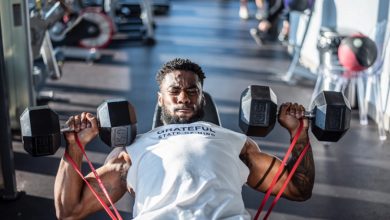
Getting stronger and building more muscle is all about getting the grind and making the uncomfortable, comfortable. And with maximum recoverable volume (MRV), you’ll be one step closer to making it happen.
Back in the day it was common for the bros to thrash out heavy set after heavy set. No end point, just effort, effort, effort.
The aim was to almost annihilate each muscle to within an inch of its cellular life, in order to promote max gains.
But they were wrong.
Maximum recoverable volume or ‘MRV’ is a concept introduced by fitness expert and f*cking jacked dude called Mike Israetel. It suggests a ceiling level where your body no longer adapts to weight training positively; but sends down the slippery slope of fatigue and injury.
You want to know the maximum you should lift on each muscle each week?
Where optimal becomes excessive?
In this article we tell you all you need to know about maximum recoverable volume…
Everything You Need to Know About Maximum Recoverable Volume (MRV)
You rock up to the gym and you’ve got that strange buzz in the pit of your stomach. The kind of feeling you get only when it’s a heavy day and chances are you’re gonna end up under a heavy ass bar for rep after rep.
You’re filled with dread and excitement in equal measure.
And you know that once the hands are chalked and the smelling salts are working their way to your brain, anything can happen.
It’s time to treat the gym like your girl back home… bend it over and show it who’s boss.
So what does MRV actually mean?
[infobox]Maximum recoverable volume is defined as the highest amount of training you can do, but still recover to perform that same workout the following time, but no more than that.
[/infobox]I other words, it’s the most sets you can complete, recover from and repeat next time without losing or gaining strength.
The load volume relationship and MRV
MRV suggests that when you smash your way through a workout (as measured by load volume – reps x sets x load), it takes an amount of time to recover.
Tougher sessions need longer recovery, and less intense ones need only a bit of recovery of course.
That makes complete sense.
Train too hard and you might not be fresh enough to repeat the same workout, to the same capacity, the following time.
But during a phase or block of training, you shouldn’t recover to the point of improving your fitness. Not until the end of the program anyway, once you deload or taper.
If you do fully recover, you probably weren’t working hard enough in the previous workout.
Remember, the purpose of any training block is to build an accumulated amount of fatigue, and then dust off that fatigue during your deload to let those god damn beautiful gains flourish for all to see.
Good training is about working as hard as you need to, not as hard as you can
If you’re a real bro you know that nothing gets in the way of your training. Even if your girl was in labor with your firstborn you’d only get to her once you’d finished the last set of arms.
Because who wants to deliver the baby without a sick pump right?
More isn’t always better.
And that’s the foundation that MRV is built upon.
Good training is about creating enough of a stimulus for your body to adapt (by getting bigger, stronger, faster) without it taking too long to recover from.
Too much can be detrimental to performance and recovery – above your MRV
So what happens if you go over your maximum recoverable volume?
Well you’ve maxed out your potential to adapt and thrown in wasted training volume. And the excess fatigue you built up along the way will take you much longer to get rid of – potentially affecting performance during the next workout.
As you know from our other articles on the subject, once excess overreaching and overtraining kicks in, you’re out of the game for a good few weeks… maybe even months.
So it’s best not to go over your MRV.
MRV is the sweet spot of muscle building process
So train below your maximum recoverable volume and progress will be slow. Train above it and you’ll not recover fully. Performance will definitely drop.
Get it right on the nose though and you’ll build muscle like a Greek god on double strength tren.

How Do You Find Your Maximum Recoverable Volume?
This is the tricky part.
You know what maximum recoverable volume is. Now you just need to work out how to find it.
And what makes it difficult to calculate is that everyone has a different tolerance to training, and therefore individual MRV.
For example, at SpotMeBro we can smash out 25 sets on big muscle groups like chest, shoulder and legs.
While you might struggle with 15.
After all, we’re much stronger than you. And you’re a pussy in comparison.
So what’s your muscle growth MRV?
The whole deal with building muscle is to increase volume load as much as possible, but still be able to recover from it. By increasing load or reps each week, you keep teasing your body into progressing – and as such it rewards you with new muscle.
For most people, MRV lies somewhere between 15-20 sets per muscle, per week.
Take a minute to let that sink in.
Evaluate it against what you’re doing in your current program.
Are you over it, under it, or bang on?
How do you assess your maximum recoverable volume?
The best way to work out MRV is educated trial and error.
The most effective method we’ve found is to bump up the volume each week and just monitor recovery as you go.
In week one, go for a total weekly number of sets/volume that is a comfortable(ish).
Each successive week from there, climb up the volume until the next phase of training.
Monitor recover as you go along:
- How do you feel? – is your mood, energy, motivation etc lower than normal and making training hard? If your desire and enthusiasm to train is really low you’re probably above your MRV.
- Are you excessively fatigued? Are you suffering from excessive muscle soreness, decreased strength output, lower than baseline performance etc? A big drop in performance will be due to higher-than-optimal muscle damage.

Other Considerations Around Optimal Training
Not only did Israetel formulate his maximum recoverable volume markers as a way of guiding your muscle building workouts, he also created other measures to run alongside it.
These are the ones you need to know about…
Minimum effective dose (MED)
Sometimes referred to as minimum effective volume (MEV), your MED is the total amount of training you need to at least stimulate some kind of muscle growth.
Fall below this marker and chances are you’ll remain a weak lil’ bitch with less muscle than a marathon runner… that’s malnourished… and terminally ill.
It’s a good place to start when you hit week 1 of a training block, or you’re starting your journey to working out your MRV too.
Your minimum effective dose usually comes in around 10-14 sets per muscle group, per week for most people.
Which is hopefully pretty low for you guys.
Maximum adaptive volume (MAV)
Your MAV is the sweet spot that lies between your MED and MRV.
It’s that place where magic happens and stringy, weak muscle becomes swole and strong.
It’s generally around 12-18 sets per muscle group, per week for most people.
Your MAV works more within a range rather than a set number of sets, plainly because you adapt so much here that you need to keep taking overload and adaptation into account as you progress each week (the weights will naturally get heavier and you reps will likely increase too).
Summary – Maximum Recoverable Volume
Maximum recoverable volume (MRV) is the theoretical point where the total number of sets performed by a muscle per week accumulates so much fatigue that your performance and results begin to suffer.
Working close to your MRV (in what’s known as the maximum adaptive volume) helps you build more muscle while accumulating just enough fatigue to force your body to adapt… but still allowing recovery to take place.






